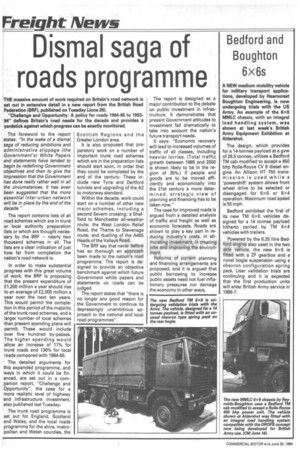Dismal saga of roads programme
Page 14

If you've noticed an error in this article please click here to report it so we can fix it.
THE massive amount of work required on Britain's road network is set out in extensive detail in a new report from the British Road Federation (BRF), published on Tuesday (June 26).
"Challenge and Opportunity: A policy for roads 1984-85 to 199394" defines Britain's road needs for the decade and provides a yardstick against which progress can be exactly monitored.
The foreword to the report states: "in the wake of a dismal saga of reducing ambitions and administrative slippage (the Government's) White Papers and statements have tended to begin by redefining Government objectives and then to give the impression that the Government has done really rather well in all the circumstances. It has even been suggested that the more essential inter-urban network will be in place by the end of the decade."
The report contains lists of all road schemes which are in trunk or local authority preparation lists or which are thought necessary by the BRF — nearly two thousand schemes in all, The lists are a clear indication of just how far from completion the nation's road network is.
In order to make substantial progress with this great volume of work, the BRF is proposing that the present expenditure of £1,200 million a year should rise to an average of £2,000 million a year over the next ten years. This would permit the completion in this period of the majority of the trunk road schemes, and a larger number of local schemes than present spending plans will permit. These would include over five hundred by-passes. The higher spending would allow an increase of 17% for trunk roads and 136% for local roads compared with 1984-85.
The detailed arguments for this expanded programme, and ways in which it could be financed, are set out in a companion report, "Challenge and Opportunity", the case for a more realistic level of highway and infrastructure investment, also published last Tuesday.
The trunk road programme is set out for England, Scotland and Wales, and the local roads programme for the shire, metropolitan and Welsh counties, the Scottish Regions and the Greater London area.
It is also proposed that preparatory work on a number of important trunk road schemes which are in the preparation lists should start soon, in order that they could be completed by the end of the century. These include new Tyne and Dartford tunnels and upgrading of the A2 to motorway standard.
Within the decade, work could start on a number of other new major schemes, including a second Severn crossing; a Sheffield to Manchester all-weather route; the West London Relief Road, the Thame to Stevenage route; and dualling of the A465 Heads of the Valleys Road.
The BRF say that never before has so thorough an approach been made to the nation's road programme. The report is designed to provide an objective benchmark against which future Government white papers and statements on roads can be judged.
The report states that "there is no longer any good reason for the Government to continue its depressingly unambitious approach to the national and local road programmes". The report is designed as a major contribution to the debate on public investment in infrastructure. It demonstrates that present Government attitudes to investment fail dramatically to take into account the nation's future transport needs.
It says: "Economic recovery will lead to increased volumes of traffic of all classes, including heavier lorries. (Total traffic growth between 1985 and 2000 is shown likely to be in the re gion of 35%.) If people and goods are to be moved effi ciently and economically into the 21st century a more determined, strategic view of planning and financing has to be taken now."
The case for improved roads is argued from a detailed analysis of traffic and freight as well as economic forecasts. Roads are shown to play a key part in re ducing industry's costs, in stimulating investment, in creating jobs and improving the environment.
Reforms of current planning and financing arrangements are proposed, and it is argued that public borrowing to increase public assets need not fuel inflationary pressures nor damage the economy in other ways.






















































































